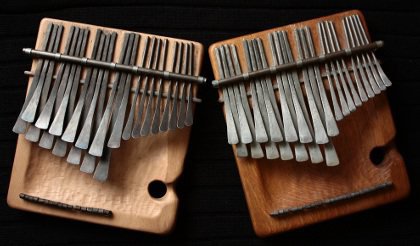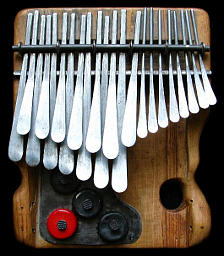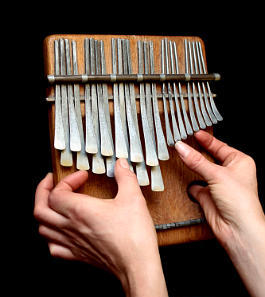Mbira dza vadzimu
Mbira dza vadzimu is the national instrument of the Shona people of Zimbabwe. For centuries, charms with its beautiful sound and accompanies the rituals serving to communicate with the spirits of ancestors. In the twenty-first century mbira gaining more popularity worldwide as a versatile and handy musical instrument.
The most important type of this instrument for Shona
people is the dza vadzimu mbira.
Has about 22 for 24 votes.

Mbira, so as karimba, belongs to a family of small lamellophones from South African. Instruments, in which the sound source is the flat piece of metal introduced in vibration directly by the player's. Formerly on mbira played only men, with time on the instrument started to play a womans. This involved some opposition of men and hinder learning, acceptance in the environment and the existence of "on stage". Currently, there are many fine musicians, men and women performing music for mbira, the traditional songs as well as brand new compositions.

1. Construction.
It consists of wooden the board, on which attached are tuned plaque (22-27), arranged in a certain way - on the left side in two rows on the right side in the one.
On the boards, put it the various add-ons - shells, bottle caps, beads. They enrich the instrument by the rattling, usually in a manner not entirely predictably.
To enhance the sound the instrument is he is being
assembled in the resonator. In Africa, traditionally
used for this purpose the dried, hollow gourd, inside
which the instrument is immobilized behind the help of
the stick . Resonator makes the mbira is so loud
audible that it may be accompanied (or even should) the
loud singing and the plaing on rattles hosho and
bass drum ngoma.
2. Playing technique
 The illustration shows the grip of
the instrument. In the bottom right of the board is a
hole, one should put in it the little finger (from
top). Grip is a more stable.
The illustration shows the grip of
the instrument. In the bottom right of the board is a
hole, one should put in it the little finger (from
top). Grip is a more stable.
On the left side - in the upper and lower section uses the left hand thumb. On the right side - with the index finger (the ones shortest, six) and with thumb (remaining). On the right side - in the upper and lower section uses the left hand thumb.
Described Playing technique above may at first seem
they are strange or difficult to use in the play, but
after a while, it becomes the one most appropriate.
Sometimes the second hole is mbiras on the left boards,
he has the same purpose as the one on the right
side.
3. Tunings
Mbira exists in many variants, while maintaining a
fixed sequence. Below I present some possibilities of
with which you can to meet. Any way to has its name.
The order is the same as when you look at the
instrument from above.
1. Mbira dza vadzimu - Nyamaropa -
b , g', a', b', c'', d'', e'', f'', g'', a'' (right row)a ', g ', f ', e ', c ', d ', g (top left row)
a , f , e , d , c , H , G (bottom left row)
This is the outfit very well known and popular. You can play on it greatest number of traditional tunes.
2. Mbira - Saungweme -
c#', a', b', c#'', d#'', e'', f#'', g#'', a'', b'' (right row)b', a', g#', f#', d#', e', a (top left row)
b , g# , f# , e , d# , c# , A (bottom left row)
3. Mbira - Katsanzira -
Eb', c'', d'', Eb'', f'', g'', a'', Bb'', c''', d''' (right row)d'', c'', Bb', a', f', g', c' (top left row)
d' , Bb , a , g , f , Eb , c (bottom left row)
Mbira melodies are in the section called "scores".
I also invite you to the page "amplification"
© Copyright
2006-2024 pracownia-promyk.pl Andrzej
Głębocki all rights reseved
use of this site means acceptance of rules
